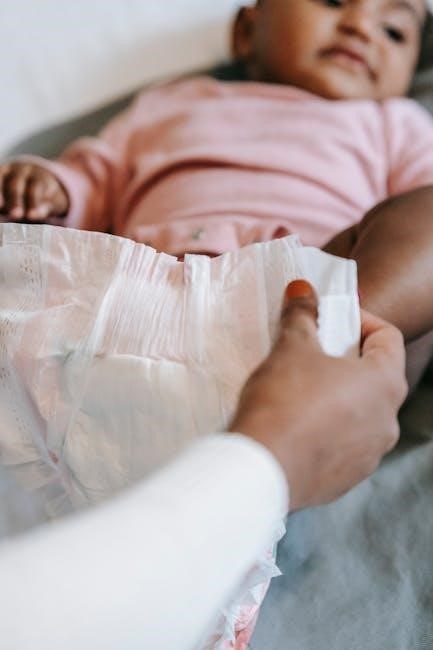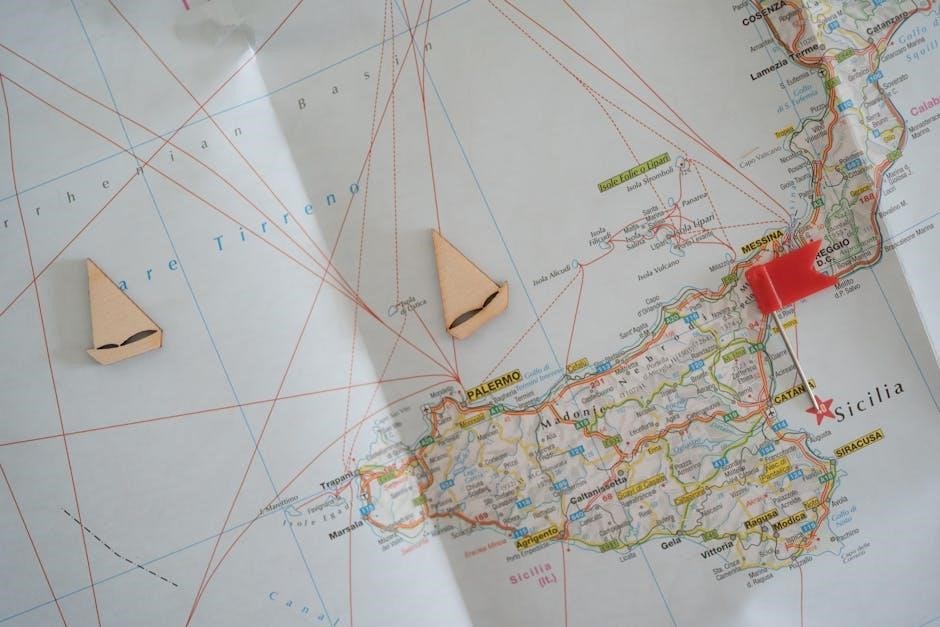Diaper stockpiling is an essential strategy for new parents, offering peace of mind and financial relief. It ensures a steady supply, saving time and reducing stress during baby’s early years.

Why Building a Diaper Stockpile is Essential
Building a diaper stockpile is crucial for new parents, offering financial savings and peace of mind. It prevents last-minute trips to the store during emergencies, ensuring you always have enough diapers on hand. Stockpiling also helps avoid the stress of running out, especially during late-night changes or unexpected situations. By purchasing diapers in bulk during sales or with coupons, you can significantly reduce costs over time. A well-stocked supply also accommodates your baby’s growth, as sizes and needs change. This practical approach ensures you’re prepared for the first year and beyond, making parenting a little easier and less overwhelming.
Benefits of Starting Early
Starting your diaper stockpile early offers numerous advantages, particularly financial savings and peace of mind. By purchasing diapers in bulk during sales or with coupons, you can significantly reduce costs. Early stockpiling also ensures you’re prepared for your baby’s arrival, eliminating last-minute stress. Additionally, it allows you to take advantage of promotions and discounts that may not be available later. This proactive approach provides flexibility, as you can adjust your stockpile based on your baby’s growth and needs. Early preparation also helps distribute the cost over time, making it more manageable. It’s a practical way to ensure you’re ready for the first year and beyond.

Planning Your Diaper Stockpile
Planning your diaper stockpile involves assessing your baby’s needs, considering storage space, and setting a budget. Use charts and guides to track sizes and quantities effectively.
Understanding Diaper Sizes and Usage
Diaper sizes vary based on baby’s weight and age. Newborn sizes fit babies up to 10 pounds, while larger sizes accommodate growth. Each size covers a specific weight range, ensuring proper fit. Monitoring your baby’s growth helps determine when to transition sizes. Usage depends on daily changes, typically 8-12 diapers per day for smaller sizes and fewer as babies grow. Stockpiling a mix of sizes ensures you’re prepared for each stage without waste. Understanding size progression helps you build a practical stockpile tailored to your baby’s needs. This knowledge is key to efficient diaper management and budgeting.
Calculating the Number of Diapers Needed
Estimating diaper usage is crucial for stockpiling. Babies use about 2,500 to 3,000 diapers in their first year, averaging 8-12 diapers daily. Start with 2-3 boxes of newborn diapers (150-300 total) and adjust as your baby grows. Larger sizes are used longer, so stockpile more of sizes 2, 3, and 4. Consider your baby’s weight and growth rate to refine your calculations. A general rule is to stockpile 1-2 boxes per size for the first year. This ensures you’re prepared without overstocking. Tailor your stockpile to your baby’s needs for optimal savings and convenience.
Creating a Diaper Stockpile Chart

A diaper stockpile chart helps track your inventory and needs. Start by listing diaper sizes (1-6, Pull-Ups) and estimate quantities based on your baby’s growth. Allocate 1-2 boxes per size for the first year. Include columns for current stock, needed diapers, and purchase dates. Update the chart regularly to avoid overstocking and ensure freshness. This visual tool simplifies planning, saving time and money. Customize it to fit your baby’s unique needs and your storage space. A well-organized chart ensures you’re always prepared without waste, making diaper management efficient and stress-free.

Strategies for Buying Diapers in Bulk
Purchase diapers in bulk during sales or use coupons for discounts. Compare online and in-store prices to maximize savings. This approach ensures a steady supply while reducing costs.
How to Find Sales and Discounts
Finding sales and discounts is crucial for building a cost-effective diaper stockpile. Check weekly ads for local stores and sign up for newsletters to stay informed about promotions. Use apps like Flipp or Retale to compare prices and find deals. Many retailers offer buy-one-get-one-free (BOGO) deals or percentage discounts during holidays. Follow diaper brands on social media for exclusive coupons and codes. Additionally, consider shopping during sales tax holidays to maximize savings. Timing purchases during these periods can significantly reduce costs while stockpiling. Always track price cycles to buy at the lowest points, ensuring long-term savings.
Using Coupons and Promotions Effectively
Using coupons and promotions is a smart way to maximize savings when building a diaper stockpile. Look for manufacturer coupons on brand websites or through loyalty programs. Many retailers offer digital coupons that can be stacked with paper coupons for greater discounts. Apps like Ibotta and Fetch Rewards provide cashback or exclusive offers. Sign up for rewards programs like Huggies Rewards or Pampers Rewards to earn points redeemable for free diapers. Combine coupons with sales for the best deals. Always check expiration dates and organize coupons to avoid missing opportunities. This strategy can significantly reduce costs while stockpiling.
Buying Diapers Online vs. In-Store

Buying diapers online vs. in-store depends on convenience and availability. Online shopping offers bulk purchasing, exclusive deals, and home delivery, making it ideal for stockpiling. In-store shopping allows for immediate use and avoids shipping costs. Consider combining both: buy in bulk online during sales and replenish in-store as needed. Check for online coupons and promotions to maximize savings. Both methods are effective, but online often provides better deals for long-term stockpiling. Choose the option that best fits your schedule and budget to ensure a steady diaper supply.

Storing Your Diaper Stockpile
Store diapers in a cool, dry place to maintain quality. Organize by size to ensure easy access as your baby grows. Use airtight containers to protect from moisture.
Best Practices for Organizing Diapers
Organizing your diaper stockpile efficiently ensures easy access and maximizes space. Start by sorting diapers by size, storing them in labeled bins or shelves. This helps prevent mix-ups and makes it easier to grab the right size as your baby grows. Consider using stackable containers or shelves to save space. Keep the most-used sizes front and center, while storing larger sizes toward the back. Rotate your stock regularly to ensure older diapers are used before they expire, preventing waste and saving money. A well-organized system keeps your nursery tidy and your mind at ease.
Keeping Diapers Fresh and Ready to Use
To keep diapers fresh, store them in a cool, dry place away from direct sunlight and moisture. Avoid exposing them to extreme temperatures, as this can affect their quality. Check diapers for visible damage or expiration dates before use, as some brands have a shelf life. Rotate your stock regularly to ensure older diapers are used before newer ones, preventing waste. For cloth diapers, wash and dry them according to the manufacturer’s instructions to maintain hygiene and longevity. Proper storage and maintenance ensure your diaper stockpile remains fresh and ready for your baby’s needs.
Space-Saving Tips for Diaper Storage
Maximize your space by using vertical storage solutions like shelves or stackable containers. Store diapers in breathable, moisture-resistant bins to protect them from dust. Consider under-bed storage for bulk supplies, keeping essentials in a diaper caddy for easy access. Label each storage area to maintain organization and quickly locate the right size. For small spaces, use vacuum-sealed bags to reduce bulk. Rotate your stock to ensure older diapers are used first, preventing clutter and waste. These tips help keep your diaper stockpile organized, accessible, and space-efficient, ensuring your home remains tidy while staying prepared for your baby’s needs.

Optimizing Your Diaper Stockpile
Monitor diaper expiration dates, adjust stock as your baby grows, and use oldest diapers first to avoid waste, ensuring efficiency and preparedness with minimal excess.
How to Avoid Waste and Overstocking
To prevent waste, start with smaller quantities of each diaper size and track your baby’s growth and usage patterns. Avoid buying excessive stock of larger sizes early on, as babies grow quickly. Rotate your stock regularly to use older diapers first, ensuring none expire unused. Store diapers in a cool, dry place to maintain quality. Consider your baby’s daily needs and adjust purchases accordingly. Overstocking can lead to wasted money and space, so balance preparedness with practicality for a stress-free diaper supply management.
Adjusting Your Stockpile as Your Baby Grows
As your baby grows, their diaper needs change rapidly. Monitor their weight and size monthly to anticipate transitions between sizes. Use up current stock before purchasing larger sizes to avoid waste. Plan ahead by buying smaller quantities of the next size during sales, ensuring you don’t overstock. Consider absorption needs, especially for overnight use, and explore different brands for better value. Organize your storage with labeled bins to track quantities easily. Balance your stockpile to match current and near-future needs, saving money and reducing waste.
Monitoring Diaper Expiration Dates
Diapers typically have a shelf life of 5 years, but it’s crucial to monitor expiration dates to ensure quality. Check the packaging for the “use by” date before purchasing in bulk. Always use the first-in, first-out rule to avoid expired diapers. Regularly inspect your stockpile for any signs of damage or degradation. If a diaper package is open, ensure it’s sealed properly to maintain freshness. Review your stockpile every 6 months to remove or use diapers nearing expiration. This practice prevents waste and ensures your baby always has fresh, reliable diapers available.

Budgeting for Your Diaper Stockpile
Set a realistic budget by estimating diaper costs over a year. Allocate funds for sales, coupons, and bulk purchases to maximize savings without compromising quality or quantity.
Setting a Realistic Budget for Diapers
Setting a realistic budget for diapers is crucial to avoid financial strain. Start by estimating monthly costs, considering factors like diaper size, brand, and usage frequency. Allocate funds for sales, coupons, and bulk purchases to maximize savings. Average costs range from $70 to $100 per month for disposable diapers. Track spending to ensure you stay within budget and adjust as needed. Utilize price comparison tools and stockpile during discounts to optimize savings without compromising on quality or quantity.
How to Save Money Without Compromising Quality
Saving money on diapers without sacrificing quality involves strategic shopping and smart planning. Look for sales and discounts, and use coupons or cashback apps to reduce costs. Buying in bulk during promotions can lower per-diaper expenses. Consider store-brand options, which often match name-brand quality at a lower price. Additionally, diaper rewards programs offer points redeemable for free products. Stockpiling during pregnancy ensures you’re prepared without overspending later. By combining these strategies, you can maintain quality while staying within your budget and enjoying long-term savings.
Tracking Your Spending on Diapers
Tracking your diaper spending is crucial for managing your budget effectively. Use a spreadsheet or budgeting app to record each purchase, including the number of diapers, cost, and date. This helps identify spending patterns and ensures you stay within your budget. Regularly review your purchases to spot trends or areas for savings. By monitoring your expenses, you can make informed decisions about bulk buying, sales, and coupon usage. This practice also helps prevent overstocking and ensures your stockpile remains aligned with your baby’s needs and your financial goals.

Additional Tips and Tricks
Explore strategies like starting your stockpile during pregnancy, using diaper rewards programs, and understanding the pros and cons of disposable vs. cloth diapers for optimal preparation.
Differences Between Disposable and Cloth Diapers
Disposable diapers offer convenience and hygiene, with easy disposal and no washing required, making them ideal for busy parents. Cloth diapers, while reusable and eco-friendly, demand regular laundering and maintenance, potentially saving money over time. Disposable diapers are more absorbent and lightweight, while cloth diapers provide a natural feel and can reduce diaper rash. Each option has pros and cons, catering to different lifestyles and preferences. Parents should consider factors like budget, environmental impact, and personal convenience when choosing between disposable and cloth diapers for their stockpile.
How to Use Diaper Rewards Programs
Diaper rewards programs are designed to help families save money by earning points on purchases; Many brands offer loyalty programs where points are accumulated with each diaper buy. These points can be redeemed for discounts, free products, or exclusive offers. To maximize benefits, sign up for programs like Huggies Rewards or Pampers Rewards. Earn points by submitting receipts or using apps. Redeem rewards for diaper discounts or other baby essentials. Track points online and combine rewards with sales for greater savings. These programs are a smart way to stockpile diapers while staying within your budget.
The Advantages of Starting Your Stockpile During Pregnancy
Starting your diaper stockpile during pregnancy offers numerous benefits. It allows you to prepare for the arrival of your baby without the added stress of last-minute shopping. By spreading out purchases over time, you can take advantage of sales and discounts, reducing overall costs. Additionally, it ensures a steady supply of diapers from day one, preventing unexpected shortages. Building a stockpile during pregnancy also gives you time to organize and store diapers effectively. This proactive approach helps you feel more prepared and confident, allowing you to focus on caring for your baby rather than rushing to buy essentials.
Building a diaper stockpile is a smart, cost-effective way to prepare for your baby’s needs, ensuring peace of mind and financial relief during the early years.
Final Thoughts on Building a Diaper Stockpile
Building a diaper stockpile is a practical and cost-effective way to prepare for your baby’s needs. By starting early, buying in bulk, and utilizing coupons, you can save money and reduce stress. Organizing your stockpile ensures diapers remain fresh and accessible. Remember, every baby grows differently, so adjust your strategy as needed. Avoid waste by monitoring sizes and expiration dates. Consistency is key—keep track of your supply and restock when necessary. With a well-planned stockpile, you’ll be ready for whatever parenthood brings, ensuring peace of mind and financial savings in the long run.
Encouragement to Stay Consistent and Prepared
Consistency is key to maintaining a successful diaper stockpile. By regularly monitoring your supply and restocking as needed, you’ll avoid last-minute purchases and save money. Stay organized, keep track of sizes, and adjust your strategy as your baby grows. Remember, every small step toward preparation contributes to a stress-free parenting journey. Celebrate your progress and stay committed—your efforts will pay off when you’re ready for whatever comes next. Your dedication to building a stockpile shows how much you care about your baby’s comfort and your family’s financial well-being.
